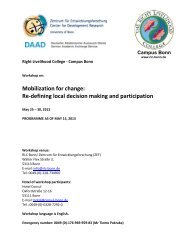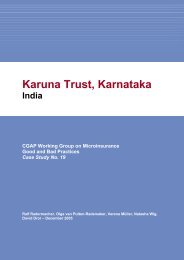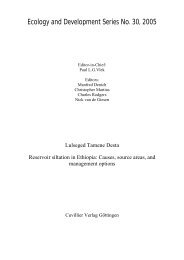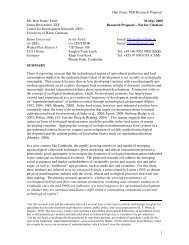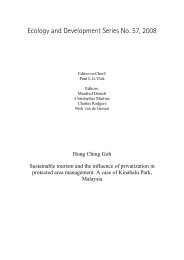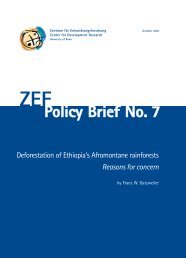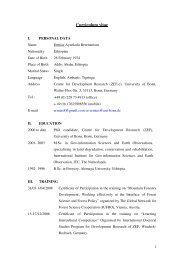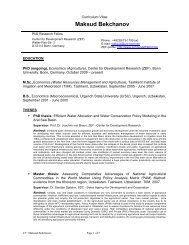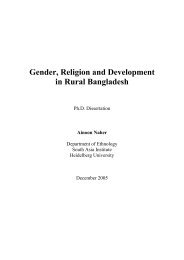Ecology and Development Series No. 10, 2003 - ZEF
Ecology and Development Series No. 10, 2003 - ZEF
Ecology and Development Series No. 10, 2003 - ZEF
- No tags were found...
You also want an ePaper? Increase the reach of your titles
YUMPU automatically turns print PDFs into web optimized ePapers that Google loves.
Current state of knowledgeseeded plants <strong>and</strong> clonal material (Maxted et al., 1997). Field gene banks are commonlyused for such plants as coffee, cocoa, rubber, coconut, mango, banana, cassava, sweetpotato, <strong>and</strong> yam. The advantages of field gene banks are that the material is easilyaccessible for utilization, <strong>and</strong> that evaluations can be undertaken while the material is beingconserved. The disadvantages are that the material is restricted in terms of genetic diversity,is susceptible to pests, disease <strong>and</strong> v<strong>and</strong>alism, <strong>and</strong> involves large areas of l<strong>and</strong>.Since the early 1960s, several individuals <strong>and</strong> organizations have made efforts tocollect, conserve <strong>and</strong> utilize coffee germplasm (Meyer 1965; FAO 1968; IAR 1986;Berthaud <strong>and</strong> Charrier 1988). The FAO Coffee Mission collected germplasm from most ofthe coffee-growing areas of Ethiopia, while Meyer’s collections were only from southwest<strong>and</strong> central Ethiopia. ORSTOM also collected coffee germplasms from wild populations inthe forests of SW Ethiopia (Berthaud <strong>and</strong> Charrier 1988), following the FAO mission. TheEthiopian National Coffee Collection Program (ENCCP) continued to collect coffeegermplasm from all over the country, including areas that were not covered by othergermplasm collection missions (IAR 1986). Accessions of germplasm collected up to noware found in different field gene banks around the world <strong>and</strong> within Ethiopia (Table 2.1).Table 2.1. Major Coffea arabica field genebank collectionsCountry Institute Total numberof accessionsBrazil a Centro Nacional de Recursos Geneticos 275Colombia a Centro Nationale de Investigaciones de Cafe´ Pedro 886Uribe MejiaCosta Rica a Centro Agronomico Tropicale de Investigacion y 1498EnseñanzaCôte d’Ivoire a ORSTOM-Institut français de recherché scientifique 1787pour le development en coopération (CATIE)Ethiopia b Institute of Biodiversity Conservation <strong>and</strong> Research 4500Ethiopia c Jimma Research Station 679India a Central Coffee Research Institute, Kamataka 329Kenya a Coffee Research Foundation 592Madagascar a Recherche Agricole a Madagascar 329Tanzania a Tanzanian Agricultural Research Organization 42USA a US Department of Agriculture 292Sources: a: Dulloo et al. 1998; b: IBCR database until February 2001; c: IAR 198623



